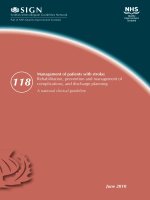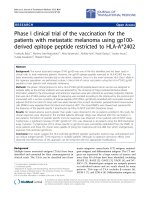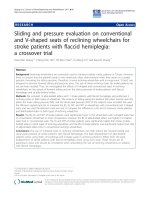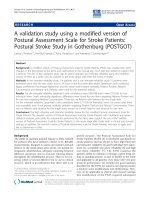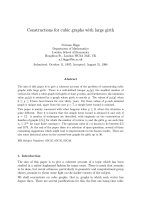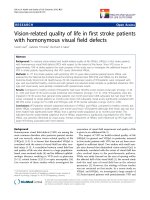INDIVIDUALIZED DIFFEOMORPHIC MAPPING FOR STROKE PATIENTS WITH LARGE CORTICAL INFARCTS
Bạn đang xem bản rút gọn của tài liệu. Xem và tải ngay bản đầy đủ của tài liệu tại đây (18.56 MB, 63 trang )
INDIVIDUALIZED
DIFFEOMORPHIC MAPPING FOR
STROKE PATIENTS WITH LARGE
CORTICAL INFARCTS
Soon Hock Wei
Department of Bioengineering
National University of Singapore
A thesis submitted for the degree of
Master of Engineering (M.Eng)
2013 JANUARY
ii
1. Reviewer:
2. Reviewer:
Signature from head of M.Eng committee:
iii
Abstract
Whole brain mapping for stroke patients with large cortical infarcts
poses a challenge to conventional automatic whole brain mapping algorithms. These algorithms minimize a quantified measure of differences between images with a pre-determined atlas, and are commonly
formulated based on parameters such as their intensity values. This
causes an ensuing mismatch in the areas of signal loss, in particular, the regions containing cortical infarcted brain tissues, as they are
not found in the atlas. In this study, we investigated an individualized approach of whole brain mapping for stroke patients with large
cortical infarcts. We proposed a framework based on Large Deformation Diffeomorphic Metric Mapping (LDDMM) with individualized
anatomical features extraction and cost function masking, for registering an atlas to a brain with large cortical infarcts. We applied this
technique to 2 separate datasets (of either real or simulated cortical
infarcts) of different databases and validated the mapping accuracy
using selected quantitative measures. Our results revealed that our
mapping technique for stroke patients produced comparable accuracy
with LDDMM for healthy controls without cortical infarcts. Hence,
we consider this as the preferred method of choice in brain image
mapping with large cortical infarcts.
Acknowledgements
I would like express my utmost heartfelt gratitude to my advisor Dr.
Qiu Anqi for her unrelenting supports and guidance throughout the
whole course of my research.
Besides, I would like to thank my lab mates who have helped me in
one way or another in this project. They are such a wonderful people
to work with.
Last but not least, my dearest family members who have never stop
believing in me.
Contents
List of Figures
iv
List of Tables
vii
1 Introduction
1.1 The Research Problem . . . . . . . . . . . . . . . . . . . . . . . .
1
1
2 Literature Review
3
2.1
Whole Brain Mapping for Stroke Patients with Large Cortical Infarcts . . . . . . . . . . . . . . . . . . . . . . . . . . . . . . . . . .
3 Aims of the project
3.1
7
Objectives . . . . . . . . . . . . . . . . . . . . . . . . . . . . . . .
4 Methodology
4.1
3
7
8
Whole Brain Segmentation and Generation of Cortical and Lateral
Ventricular Surfaces . . . . . . . . . . . . . . . . . . . . . . . . . .
9
4.2
4.3
The Extraction of Individualized Anatomical Features . . . . . . .
Individualized Large Deformation Diffeomorphic Metric Mapping
10
11
4.4
Quantitative Evaluation of Whole Brain Mapping Accuracy . . .
14
4.4.1
Curve Variation . . . . . . . . . . . . . . . . . . . . . . . .
15
4.4.2
4.4.3
Surface Alignment Consistency . . . . . . . . . . . . . . .
Dice Overlap Ratio . . . . . . . . . . . . . . . . . . . . . .
16
17
5 Results
5.1
23
Experiment I: Simulated Lesion . . . . . . . . . . . . . . . . . . .
ii
23
CONTENTS
5.2
5.1.1
Lesion Simulation . . . . . . . . . . . . . . . . . . . . . . .
24
5.1.2
5.1.3
Data Processing . . . . . . . . . . . . . . . . . . . . . . . .
Quantitative Evaluation . . . . . . . . . . . . . . . . . . .
25
26
Experiment II: Brain Images of Stroke Patients . . . . . . . . . .
30
5.2.1
Lesion Location . . . . . . . . . . . . . . . . . . . . . . . .
30
5.2.2
5.2.3
Data Processing . . . . . . . . . . . . . . . . . . . . . . . .
Quantitative Evaluation . . . . . . . . . . . . . . . . . . .
31
32
6 Discussion
44
7 Conclusion
48
8 Future Work
49
References
50
iii
List of Figures
4.1
Overview of whole individualized diffeomorphic mapping
framework. Panel A shows the initial atlas and the subjects brain
with large left temporal infarct. Panel B illustrates the preprocessing stages which encompass whole brain segmentation and surfaces
generation. Notice the partially missing temporal lobe on the generated cortical surface for the subjects brain. Panel C shows the
extraction of individual anatomical features, whereby the curves
were selectively delineated around the infarcted region and the
portion of cortical infarcted surfaces was removed. These anatomical features were correspondingly extracted for the atlas of each
individual stroke patient as well. Lastly, LDDMM was performed
to seek an optimal diffeomorphic transformation to simultaneously
carry these anatomical features from atlas native space to the subjects brain space. . . . . . . . . . . . . . . . . . . . . . . . . . . .
4.2
Schematic diagram of the individualized whole brain mapping procedure for stroke patients with large cortical infarcts. . . . . . . . . . . . . . . . . . . . . . . . . . . . . . . . . .
4.3
18
19
Seventeen sulcal regions on superior, inferior, lateral and
medial views. Label abbreviations are listed in Table 4.2. . . .
iv
20
LIST OF FIGURES
5.1
Four stroke patients brains with unilateral cortical infarcts
used in experiment 1 (A)-(D). Example of 4 simulated
cortical infarctions in a normal brain (E)-(H). Panel (E)
shows a slice from axial view of normal brain, and the same slice
with simulated left frontal cortical infarction inserted. Similarly,
panel (F)-(H) illustrate a different slice view of the same normal
brain, with cortical infarctions in 3 other lobes inserted, i.e. left
occipital, right temporal and right parietal lobes. . . . . . . . . .
5.2
34
Brains with simulated cortical infarcts and their anatomical features extracted for mapping. Each row shows one type
of simulated cortical infarct cases. In each row, the lesion mask
was colored in red in the original stroke patients brains, and the
anatomical features extracted from atlas were displayed at the top
of each row while the anatomical features extracted from subject
were displayed at the bottom of each row. . . . . . . . . . . . . .
5.3
35
Mapping results of experiment 1. Each row depicts the mapping results for one type of simulated cortical infarcts. In each row:
atlas, displacement field, deformed atlas and subjects image with
simulated infarct were shown from left to right. The anatomical
features of deformed atlas were displayed at the top of each row
and the anatomical features of subject were shown at the bottom
5.4
of each row. . . . . . . . . . . . . . . . . . . . . . . . . . . . . . .
The variation errors of the curves for all four cases of
36
simulated cortical infarcts in experiment 1. Due to distinct
infarct locations, the number of curves involved in each case varies:
23 curves for subjects with simulated frontal infarct, 15 curves for
subjects with simulated occipital infarct, 24 curves for subjects
with simulated temporal infarct and 20 curves for subjects with
simulated parietal infarct. Label abbreviations are listed in Table
5.5
4.1. . . . . . . . . . . . . . . . . . . . . . . . . . . . . . . . . . . .
The surface alignment consistencies for 17 sulcal regions
37
in experiment 1. Label abbreviations are listed in Table 4.2. .
38
v
LIST OF FIGURES
5.6
The Dice overlap ratio in experiment 1. The segmentation labels are: cerebral white matter (CrWm), cerebral cortex
(CrCtx), lateral ventricle (LtVent), thalamus proper (Thal), caudate (Caud), putamen (Put), pallidum (Pall), hippocampus (Hipp),
amygdala (Amyg). . . . . . . . . . . . . . . . . . . . . . . . . . .
5.7
39
Brains of stroke patients in Experiment 2. Starting from
top left and going clockwise the location of cortical infarcts are: 1)
right temporal-parietal infarct, 2) left temporal-parietal-occipital
infarct, 3) right frontal infarct, 4) right temporal-parietal infarct,
5) left temporal-parietal-occipital infarct, 6) right frontal-temporalparietal infarct, 7) right frontal infarct, 8) left temporal infarct, 9)
right temporal-parietal infarct, 10) left temporal parietal infarct,
11) right parietal-temporal-occipital infarct, 12) right temporal infarct, 13) left frontal infarct, 14) right frontal infarct, 15) right
frontal infarct. . . . . . . . . . . . . . . . . . . . . . . . . . . . . .
5.8
40
Example of image volume and anatomical features extracted for mapping in experiment 2. (A) Atlas image volume. (B) Stroke patients brain (brain 4 in Figure 5.7). (C) Stroke
brain with red colored lesion mask. (D) Anatomical features extracted from atlas for mapping. (E) Anatomical features extracted
from subject for mapping. . . . . . . . . . . . . . . . . . . . . . .
5.9
41
Example of mapping results in experiment 2. (A) Atlas
image volume. (B) Displacement field of deformed atlas. (C)
Deformed atlas image volume. (D) Stroke patients brain (brain
4 in Figure 9). (E) Anatomical features of deformed atlas. (F)
Anatomical features of subject. . . . . . . . . . . . . . . . . . . .
5.10 Quantitative measures used for validation in experiment
42
2. Due to different infarct locations, those subjects with missing
curves and sulcal regions were considered as missing data. Only
2 curves (CC and OS) and 5 sulcal regions (SFS, SPreCes, CeS,
IPreCeS and CiS) prevailed in all 15 stroked brains. Label abbreviations are listed in Table 4.1 (curves) and Table 4.2 (sulcal
regions). . . . . . . . . . . . . . . . . . . . . . . . . . . . . . . . .
vi
43
List of Tables
4.1
Curves and Abbreviations. . . . . . . . . . . . . . . . . . . . .
21
4.2
Sulcal Surfaces and Abbreviations. . . . . . . . . . . . . . . .
22
vii
1
Introduction
1.1
The Research Problem
Whole brain mapping (also known as brain spatial normalization, brain registration or brain alignment) is widely used in neuroimaging research to align the
brains onto some common stereotactic space. This is particularly important in
fMRI studies, in which the aforementioned technique is often employed to transform brains for group analysis and comparison. In the context of brains with large
cortical infarcts, precise brain mapping improves the presentation and analysis of
lesion locations and any associated behavioral changes (1). Nevertheless, whole
brain mapping for stroke patients with large cortical infarcts poses a challenge to
conventional automatic whole brain mapping algorithms. These algorithms minimize a quantified measure of differences between images with a pre-determined
atlas, and are commonly formulated based on parameters such as their intensity
values. This causes an ensuing mismatch in the areas of signal loss, in particular, the regions containing cortical infarcted brain tissues, as they are not found
1
1.1 The Research Problem
in the atlas. This could cause the normalization algorithm to attempt further
transformation in order to minimize the cost function, even in cases where optimal matching for other healthy brain tissue has already been achieved. This
confounded and biased normalization usually leads to significant and inappropriate image distortion.
2
2
Literature Review
2.1
Whole Brain Mapping for Stroke Patients
with Large Cortical Infarcts
Thus far, there are only a few available brain mapping approaches that deal
with brain images with large cortical infarcts. An early solution implemented
a linear affine registration which accounted only for the overall size, shape, position and orientation of the brain, resulting in poor and restricted fitting of
the local structures. As detailed non-linear warping was not performed by the
algorithm, distortions were not introduced in and around the infarct area. Alternatively, enantiomorphic normalization (2) essentially creates an artificial brain
by replacing the lesion volume with a homologous volume from its contra-lateral
hemisphere. Non-linear normalization parameters were estimated from this artificial brain and were then, applied onto the original. This method, however, is
only applicable to unilateral cortical infarctions and assumes, erroneously, that
3
2.1 Whole Brain Mapping for Stroke Patients with Large Cortical
Infarcts
the brain is symmetrical, despite clear evidence saying otherwise (3). Ashburner,
J. et al introduced an iterative unified model that combines segmentation, bias
correction, and spatial normalization with the use of tissue map priors of the
white matter, gray matter and cerebrospinal fluid (CSF) (4). Multiple Gaussian
models for tissue segmentation distinguish infarcted and healthy brain regions,
while bias correction may model the infarcted tissue as an area of inhomogeneity.
Hence, spatial normalization of cortical infarcts in this approach benefits from
the segmentation and bias correction in an integrative manner. Brett and colleagues (1) proposed a cost function masking (CFM) approach by masking off
the lesion voxels when calculating differences between two brain images. This
approach significantly improved the non-linear normalization results and outperformed non-linear normalization (without CFM) approaches in SPM99. One
associated drawback, however, is the manual and laborious delineation of a lesion
mask for each infarcted brain. In spite of its tediousness, CFM remains widely
used. In 2010 (5), Anderson and colleagues highlighted its importance by showing that even with the use of the unified segmentation approach (4), the cost
function masking remains necessary in normalizing brain images with chronic infarcts. However, both CFM and unified segmentation approaches are based on
small deformation model, limiting its use for diffuse infarction pathology.
Aligning brain images with large cortical infarcts has thus far limited to
volume-based nonlinear registration approaches. Such approaches seek the deformation that is driven by intensity information, and hence, provide accurate
mappings in subcortical and ventricular regions where intensity contrast is clear
and structural shapes are relatively simple. However, these approaches fail to
accurately align the cortical region since the convoluted cortical sheet cannot be
4
2.1 Whole Brain Mapping for Stroke Patients with Large Cortical
Infarcts
well characterized based on image intensity alone. There is an additional need
to consider the geometric property of the cortex as functionally distinct regions
are close to each other in a volume space but geometrically distant in terms of
distance measured along the cortex. Such a geometric property of the cortex has
been well preserved in a cortical surface model (6, 7). Registration approaches
based on cortical surfaces (6, 8, 9, 10) have shown superior performance in the
alignment of highly complex cortical folding pattern over volume-based registration approaches, and thus resulted in increased statistical power for averaging of
functional data in the cortical region across subjects (11).
Recent works by Postelnicu et al. (12) and Joshi et al. (13, 14) have employed the sphererical cortical surface mapping implemented in FreeSurfer (6) or
the harmonic cortical surface mapping constrained by gyral/sulcal curves (13, 14)
to first seek the deformation field on the cortical boundary and then extend it
to the 3D volume for further brain volume registration. These two approaches
have shown tremendous improvement in mapping accuracy when compared to
the advanced volume-based approach, hierarchical attribute matching mechanism
for image registration (HAMMER) (15), where geometric features of the cortex
have been intrinsically incorporated. Only recently, Du et al. (16) proposed
the approach providing an one-to-one, differentiable, and invertible deformation
field that simultaneously aligns gyral/sulcal curves, cortical surface, and intensity
image volume from one subject to the other under the framework of large deformation diffeomorphic metric mapping (LDDMM). This approach with superior
mapping accuracies (for both cortical and subcortical structures) as compared
to LDDMM based solely on image intensity, combined volumetric and surface
registration (12) and hierarchical attribute matching mechanism for elastic reg-
5
2.1 Whole Brain Mapping for Stroke Patients with Large Cortical
Infarcts
istration (HAMMER) (15). Nevertheless, there is no literature evidence to show
that this approach works well with brains with large cortical infarcts.
6
3
Aims of the project
3.1
Objectives
In this study, we aimed to register a brain atlas to brains with large cortical infarcts, and to achieve good alignment in the intact cortical and subcortical regions
of the infarcted brains. Hence, we employed the whole brain LDDMM algorithm
described in (16) and proposed a brain mapping framework that individualizes
anatomical features, such as cortical surfaces, sulcal/gyral curves, surfaces of the
lateral ventricles, and intensity images. We incorporated these individualized
anatomical features into the LDDMM algorithm to 1) mask out cortical infarct
regions; 2) well constrain the boundary of cortical infarcts; 3) well align anatomical features in the intact brain regions. We quantitatively validated this mapping
framework in terms of gyral/sulcal curve anatomical variation, sulcal region alignment, as well as structural segmentation in both cortical and subcortical regions
using brain images with simulated cortical infarcts and brain images of stroke
patients.
7
4
Methodology
In this section, we will describe a new framework for aligning brain image of
a healthy brain to a targeted brain image with large cortical infarcts using the
whole brain diffeomorphic metric mapping introduced in (16). This framework
will incorporate the information of subjects cortical infarcts in the image volume as well as the cortical surface to aid the mapping process. As illustrated
in Fig. 4.1, this framework consists of three major processes: 1) whole brain
segmentation and the generation of cortical and lateral ventricular surfaces; 2)
the extraction of individual anatomical features, including cortical surfaces, gyral
and sulcal curves; and 3) individualized large deformation diffeomorphic metric
mapping (LDDMM). Fig. 4.2 illustrates the detailed schematic diagram of this
individualized whole brain mapping procedure.
8
4.1 Whole Brain Segmentation and Generation of Cortical and
Lateral Ventricular Surfaces
4.1
Whole Brain Segmentation and Generation
of Cortical and Lateral Ventricular Surfaces
In this stage, the intensity-inhomogeneity corrected T1-weighted MR images of
stroke patients (17) were first brought to the Montreal Neurological Institute
(MNI) space using the affine transformation with maximizing the cross-correlation
of the subjects images with the atlas (18). In MR images, intensity inhomogeneity which are caused by magnetic settings, patients’ position, and other factors
are not unusual. These steps reduced the effects of intensity-inhomogeneity on
input MR images and aligned them to a common space for further downstream
processing. After that, FreeSurfer pipeline (19) is applied to reconstruct the inner (white matter) and outer (gray matter) cortical surfaces. The outer surface is
constructed by propagating the inner surface to the boundary of gray matter and
CSF via a flow with the force based on the image labeling and gradient such that
the topologies of the outer and inner surfaces are preserved (19). The inner and
outer surfaces are used to represent the geometry of the cortex (see an example
in Fig. 4.1B). Notice that the cortical infarcted regions are labeled as CSF in
FreeSurfer (red colored mask in Fig. 4.1B).
To overcome the common issue in misalignment of the lateral ventricles due
to its extreme enlargement in stroke patients, we also included the lateral ventricle surfaces into our framework (see an example in Fig. 4.1B). We generated the
lateral ventricle shapes of each individual subject with properties of smoothness
and correct topology by injecting a template shape into them using the LDDMMimage mapping algorithm (20). The lateral ventricle template shape was created
from 41 manually labeled lateral ventricles via a large deformation diffeomorphic
9
4.2 The Extraction of Individualized Anatomical Features
template generation algorithm (21). Each lateral ventricle volume was approximated by the transformed template through the LDDMM diffeomorphic map.
The mathematical derivation of this template injection procedure and its evaluation on a variety of subcortical structures have been detailed elsewhere (20).
This delineation approach had been successfully used to investigate the subcortical shapes in Alzheimer’s disease (22), hippocampal shapes in geriatric depression
(23), thalamic shape in schizophrenia (24), and the basal ganglia shapes in ADHD
(25).
4.2
The Extraction of Individualized Anatomical Features
In this section, we first described the manual extraction of cortical infarct regions
from the image as well as the cortical surfaces and then the semi-automated
extraction of sulcal/gyral curves from the cortical surfaces. This extraction is
done for every stroke patient and its corresponding atlas.
Firstly, a binary mask of the stroke lesion was created manually by depicting the boundaries of the lesion directly into T1 image using FSL View software
(26). Based on this mask, we then semi-automatically removed the cortical surfaces using dynamic programming to track the shortest path encompassing the
cortical infarcted region within the binary mask (see an example colored in red
in Fig. 4.1C) (27). Finally, we then transfer this binary mask to the atlas image
using affine transformation in order to mask the corresponding infarcted regions
in the atlas space (28).
10
4.3 Individualized Large Deformation Diffeomorphic Metric Mapping
Next, up to 52 curves (26 curves (i.e. 12 gyri and 14 sulci) for each hemisphere, as shown in Table 4.1 were semi-automatically delineated outside the
lesion using dynamic programming (27). These curves are chosen because they
are consistently present and easily identifiable on the cortex. The anatomical
definitions of these curves are described in Zhong et al., 2010 (10, 29) and online
( Briefly,
the initial starting and ending points of each curve are manually defined on the
middle surface and the gyral (or sulcal) curve between them is automatically generated using dynamic programming by maximizing (or minimizing) the curvature
information along the curve (27). The choice of the curves drawn was limited by
the location of the infarct.
4.3
Individualized Large Deformation Diffeomorphic Metric Mapping
In this study, we adopted Large Deformation Diffeomorphic Metric Mapping (LDDMM) algorithm given in (16). We introduced two weight functions to incorporate cortical lesion information in the image volume as well as the cortical surface
(as illustrated in Fig. 4.1, lesion mask colored red in both image volume and cortical surface). They helped to exclude the abnormal infarcted brain tissue from
the cost function calculation. In addition, we incorporated lateral ventricular
surfaces to overcome the common issue in misalignment of the lateral ventricles
due to its extreme enlargement in stroke patients.
In the initialization of LDDMM, we identified the momentum values through a
11
4.3 Individualized Large Deformation Diffeomorphic Metric Mapping
coarse-to-fine multi-manifold LDDMM (MM-LDDMM) cortical surface mappings
when the sulcal and gyral curves as well as the middle surface are considered
as mapping objects (10, 29), and LDDMM landmark mapping (30). We first
smoothed the middle surface in this coarse-to-fine approach. Then, the smooth
surface was registered with its sulcal and gyral curves to those of the target using
MM-LDDMM described in (10, 29). After that, the paired correspondence points
between the target surface and the atlas surface deformed by MM-LDDMM was
obtained using the shortest distance criteria, which in turn were being used in the
LDDMM-landmark mapping to find the time-dependent momentum that drives
the template inner and outer surfaces to those of the target.
After the initialization, LDDMM was performed to seek an optimal diffeomorphic transformation to simultaneously carry these anatomical features from atlas
native space to the target brain space. Here, we numerically solved this individualized whole brain mapping problem for target brain with large cortical infarcts
with respect to momentum. We first represent the ambient space, Ω ⊂ R3 , usi
N xi
Nx
γ
γ
γ
Sc
Sc
Sc
Sv
ing a finite number of points, Ω ∼
= {(xIi )N
i=1 } ∪i=1 {(xj )j=1 } ∪i=1 {(xj )j=1 ∪i=1
n
x
i NS i
v
{(xSj v )j=1
} for
y
N
i
nSv
Sc i
{(yjSc )j=1
∪i=1
i
n
i
n
Ny
nSc
nγ
γi
γi
the atlas coordinates and Ω ∼
= {(xIi )N
i=1 } ∪i=1 {(yj )j=1 } ∪i=1
Ny i
Sv i
Sv
{(yj )j=1
}
for the target coordinates. Here, (xIi )N
i=1 is a regi
n
N xi
γ
γ
i
i
ular grid on images Itemp
(x) and Itarg
(x), i = 1, 2, · · · , nI ; ∪i=1
{(xγj )j=1
} and
y
nγ
γ i Nγ i
∪i=1 {(yj )j=1 }
i
are the curve sets with respective tangent vectors wxγj of the tem-
i
plate and w˜yγj of the target, where Nγxi and Nγyi denote the number of points in
i
n
Nx
i
sc
Sc
the curve γ i of the template and target respectively. Similarly, ∪i=1
{(xjSc )j=1
,
Nx i
nsv
Sv i
Sv
∪i=1 {(xj )j=1
}
and
Ny i
nsc
Sc i
Sc
∪i=1 {(yj )j=1
}
,
Ny i
nsv
Sv i
Sv
∪i=1 {(yj )j=1
}
are the cortical surface
i
and lateral ventricular surface sets with respective normal vectors wxSj of the ati
las and w˜ySj of the target, where NSxc i , NSxv i and NSyc i , NSyv i denote the number of
12
4.3 Individualized Large Deformation Diffeomorphic Metric Mapping
point in the cortical surface Sc i and lateral ventricular surface Sv i of the atlas and
i
i
target respectively. Lastly, we would like to define currents, µγatlas
, µSatlas
and
i
i
µγtarg
, µStarg
, which are mathematical objects representing curves and surfaces for
both atlas and target:
N xi
γ
i
wxγj ⊗ δxj
i
µγatlas
=
j=1
N xi
S
i
wxSj ⊗ δxj
i
µSatlas
=
j=1
N yi
γ
i
w˜yγj ⊗ δyj
i
µγtarg
=
j=1
N yi
S
i
w˜ySj ⊗ δyj
i
µStarg
=
j=1
i
i
These currents are essentially measure of tangent vectors wxγj , wyγj or normal
i
i
vectors wxSj , wySj evaluated at point xj /yj . Putting all these together, the discrete
form of energy functional equation can be defined as:
13
4.4 Quantitative Evaluation of Whole Brain Mapping Accuracy
1
J(αt ) =
α(t, xi ) · kV (φt (xi ), φt (xj ))α(t, xj )dt
inf
α(t):φ˙ t =kV α(t,φt ),φ0 =id
nI
+
N
2
i
I
i
I
i I
Iatlas
(φ−1
1 (xj )) − Itarg (xj ) W (xj )
λI i
i=1
nγ
0 x ∈Ω x ∈Ω
i
j
j=1
2
i
i
λγ i φ1 · µγatlas
− µγtarg
+
i=1
NSx
nSc
+
ci
NSy
ci
i
i
˜ Sci (yk )w˜ Sci ]
kwSc (ˆ
xj , yk )[W Sc (xj )wˆxSjc ] · [W
yk
λSc i
i=1
nSv
γ
kW
j=1 k=1
2
i
i
λSv i φ1 · µSvatlas
− µSvtarg
+
i=1
Sv
kW
,
(4.1)
i
γ
Sc
where wˆxSj is the normal vector of transformed surface patch, xˆj = φ1 (xj ), kW
, kW
Sv
and kW
are kernels associated with curves, cortical surfaces and lateral ventricular
surfaces respectively, and µγ , µSc and µSv are the currents for curves, cortical
surfaces and lateral ventricular surfaces. W i (xIj ) is the image weight mask to
i
include only the healthy brain tissue, i.e. inverse of lesion brain mask; W Sc (xj )
˜ S i (yk ) is the weight mask
is the weight mask for the atlas’ cortical surface and W
c
for the subject’s cortical surface.
4.4
Quantitative Evaluation of Whole Brain Mapping Accuracy
In order to evaluate the accuracy of our proposed individualized whole brain
mapping technique, we have identified several criteria from the literature, which
14
